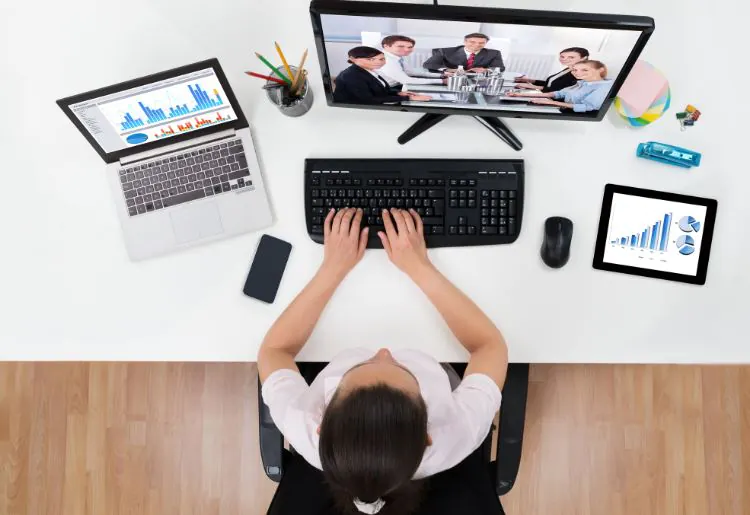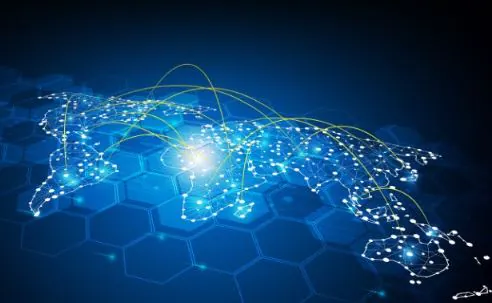The online B2B buying behavior has drastically changed in recent years, the modern B2B buyer journey map looks different in 2020 than it did in the past. The modern B2B buyer increasingly trusts technology to anticipate what they want, and that buyer now also trusts technology to assist in making their purchases for them, too. In many cases, the new B2B buyer journey in 2020 isn’t just a journey — it’s immediate, customized, targeted, and seamless.
B2B buying has changed, and your sales strategy must, too. This post is for you if you want to understand BizVibe’s 6 stages of the modern B2B buyer’s journey and how to map that to your buyers. You’ll also learn the importance of the B2B buyer’s journey and why it’s pertinent to you.
67% of the buyer’s journey is now done digitally.
BizVibe addresses all 6 stages of the B2B buyer’s journey and helps map out the process for you. Sales reps are already using BizVibe to make their B2B customer journey simpler and more effective.
What is B2B? B2B is Business to Business marketing. 55% of B2B buyers search for information on social media — the modern B2B market is full of buyers that are information seekers and your sales strategy must cater to everyone involved in the B2B buyer journey in 2020 to achieve an effective, scalable and consistent sales strategy. A B2B marketer needs to be focused and teach with marketing materials. The most effective marketing message will focus on how your product or service saves time, money and resources for your buyers. It also should solve a problem — or multiple problems — that they might have. This is where you need a well-thought-out understanding of your B2B buyer’s journey.
What is the B2B Buyer’s Journey?
In the B2B world, anyone who makes and influences buying decisions for their business is also a consumer. The B2B buyer’s journey is a must-have as part of your sales strategy, as it is the process that your buyer becomes aware of your product or service. The modern B2B buyer journey can be mapped to a 6-step process as identified by BizVibe: the problem identification stage, solution exploration stage, solution evaluation stage, internal consensus stage, decision justification stage, solution success stage.
Don’t be confused by the typical 3 stage process many sales blogs tell you about; a 3 step B2B buyer journey is incomplete and not a modern approach to what your sales strategy should be in 2020. What is the buyer’s journey certification and why’s it different from the old 3 step approach? The modern buyer’s journey map must consider the experience your prospect goes through in the six-stage process of learning about your brand and even the post-purchase experience of that experience. The set of actions that a buyer goes through after buying your product is as important as any step in the B2B buyer’s journey.
You’d be forgiven for assuming they are being influenced by these changes in the same way, but that’s a dangerous assumption to make.
Importance of B2B Buyer Journey
Why is it important to understand the B2B buyer’s journey? This is because the B2B buyer’s journey is one of the most important elements in your sales strategy. Without it, you have a bunch of ill-organized strategies that sometimes can lead to a bit of success, but doesn’t truly tap into the potential of your product’s place in the market. For your buyer, the sales strategy needs to be successful through all stages of the buying process. As a good B2B seller/marketer you need to understand your buyer through each stage and your marketing needs help move them easily and seamlessly through each stage, right to the end where they are satisfied with your product and or service and will now recommend you to other businesses. This increases your referral multiplier — and truly unlocks the sales potential of your business (more about this later).
B2B Buyer Journey Statistics
You understand the importance of the B2B buyer’s journey in 2020, but here are some cold hard facts about why the buyer’s journey in B2B is important.
- B2B buyers spend up to 90% of the decision journey educating themselves.
- 63% of consumers need to hear company claims three to five times before they actually believe it. You have multiple chances to convince your buyer that your product or service is the solution.
- B2B buyers are typically 57% of the way to a buying decision before actively engaging with sales. This is why marketing is as crucial to success as sales.
- You need to market to millennials. 73% of Millennial workers are involved in decisions to purchase products or services for their companies.
B2B Buyer Journey Mapping: Map each journey to phases
The new b2b customer journey is changing and adapting for the better, here is what sales need to know. You need to map the B2B buyer journey for your audience, at this stage you are spotting pattern and figuring out where to position your solutions.
Typically, and as mentioned earlier, B2B buyers’ journeys are often broken down into phases of the purchase decision process. The traditional phases are Awareness, Consideration, and Decision. However, Focusing on just these stages can lead you to miss out on all the potential other opportunities there along the way. The modern buying process involves pretty much everyone and you need to address everyone throughout the journey.
For example, say you are a Brazilian soybean farming company that sells to buyers of soybean seeds in the global market. You want to understand what are the questions around imports, exports, policies that your buyers have. You then want to focus on a customer life cycle with previous and current success to map out why these buyers renew a contract? Why they buy more? Which markets are they gravitating towards in the future?
BizVibe’s 6 Step B2B Buyer Journey Process
At BizVibe we use the following 6 stage process of the B2B buyer’s journey with sellers on the platform and walk them through the buyer journey for their new potential clients. We tailor them specifically to the needs of the client’s business, however, a majority of them tend to include a version of these six phases, though.
1. Problem Identification Stage:
The prospect recognizes they have a problem and tries to name the specific issue the organization is facing. Say the soybean seed buyer is not convinced in the demand for your product? But you know as a supplier of soybeans to Brazil that demand will grow as the developing world gets richer. At this stage, we help the seller really understand what the problem the potential client is facing.
2. Solution Exploration Stage:
At this stage, the prospect will research a wide range of solution including your competitors’ solutions. At this stage, your marketing needs to stand out and address all the problems the buyer has and must answer them better than your competitors. The buyer finds your company with all the material they need to do business with you including online platforms, directory listings, industry factsheets, brochures, delivery, procurement guidelines.
You want to make yourself as presentable as possible at this stage. List yourself on BizVibe and make the process simpler.
3. Solution Evaluation Stage:
This is where the prospect narrows down the long list of possible solutions to a few options and begins to evaluate the pros/cons/fit of a shortlist of solutions. At this stage, you can begin to understand the effectiveness of your marketing and need to consistently adapt to what works for the buyer and what doesn’t. It’s also very important that you are able to measure the effectiveness of your marketing and sales process here.
4. Internal Consensus Stage:
The prospect consults with their key decision-makers at the company about the various solutions they have evaluated and often presents a preferred path. The main documents used at this stage in B2B are purchase orders, invoices, delivery notes, requisitions, specifications, receipts and also rejection notes.
Reminder: 72% of B2B buyers are most likely to share useful content via email.
You want to make sure you consistently hit this stage at a more effective rate than your competitors? Go all digital, starting with BizVibe in the prior steps and you can share all the materials you need to directly from our online platform.
5. Decision Justification Stage:
The key decision-makers determine which solution is the one they want to move forward with considering their problem, the range of solutions evaluated, and the solution fit to their organization for their preferred path forward.
6. Solution Success Stage:
The prospect (now customer) evaluates if your company is delivering on the solution you sold them and if it’s continuing to fit their needs.
70% of B2B buyers cite company reputation as the most influential factor when choosing which company to do business with.
At this stage, if you’ve fulfilled all stages effectively, not only is the company going to keep doing business with you but at this stage, they’ll recommend you to other businesses — increase your sales multiplier.
In each of these stages, you have to ask the following questions that are critical to successfully understanding the B2B buyer’s journey.
- What are the key decision-makers ’ needs at this point in the buying process?
- What key questions do they have that need to be addressed for them to move forward?
- What type of content or resources can you offer them to address these needs? How do they learn best? Which sources do they trust?
- What type of messaging will resonate with their needs at this moment?
- Which platforms are they most likely to encounter this message, and will it be impactful?
Using the BizVibe platform you can display your solution to the buyer through their entire journey on the platform, whether through an industry-focused white paper you would like to publish as a PDF, or through a listing to your business and contact to your salespeople.
More About the B2B Decision Making Journey
The most important thing to understand is that the B2B purchase journey goes through a wide range of distinct and nuanced steps and that different types of content are required at each stage of the B2B buyer’s journey.
That’s because B2B buyers face significantly different challenges at different stages of the sales funnel.
After receiving an RFP from the prospective B2B buyer, marketers or sales know that they need to respond back with a proposal. But they also know that they can’t use a proposal to trigger the RFP, for which they need feature lists and capability documents. Likewise, while a feature list or capability document can be used to progress a qualified lead to the RFP stage, they won’t be able to generate the qualified lead in the first place. For that, vendors need flyers, datasheets, offering detail notes, landing pages, and other types of content that support their go to market themes and marketable offerings.
B2B buyers also don’t necessarily want a shorter journey. It is said that emotional stakes for B2B decisions are often far higher than for B2C ones. That’s why the B2B buyer’s journey is increasingly autonomous and not necessarily automatic. You’ve seen the stat claiming B2B buyers spend up to 90% of the decision journey educating themselves. Modern buyers are more informed than you think. They use this content to delay the moment when they need to reach out to a sales rep – not because they don’t like talking to sales, but because they want to exercise independent judgment and form an initial impression first. The last thing they want is to be easily led.
Make the B2B Buyer Journey Simpler with BizVibe
Now that you fully understand the B2B Buyer Journey in 2020 and how to map its process, you are ready to make the next seamless step. You need to market to a digital audience to successfully sell to B2B buyers — Millennial B2B buyers cited Internet search and vendors’ websites as their top two means of researching products and services.
Here at BizVibe, we innovated the modern B2B marketplace to make connecting to all different types of buyers in B2B simpler, smarter and more hassle-free. Join today to benefit from a list of features that will easily help you find and connect with B2B buyers online, including:
- The all-in-one sales intelligence platform: Target, Research, and Communicate with active B2B buyers
- Leverage detailed company insights for 1 million+ profiles receive real-time news alerts for your shortlisted suppliers
- Create prospect lists from scratch & upload your own lists.
- Receive real-time notifications for important news on your buyers



